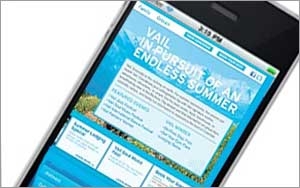
Personalization and mobile
optimization are key components to increasing email marketing ROI in the travel industry through every stage of the customer lifecycle,
according
to a case study released by Travelink, American Express Travel and Act-On Software last week.
Travelink’s credits an increase in open rates to Act-On Software’s multichannel
approach and responsive design, something the marketing team lacked two years ago. Without lead management integration, it was difficult to judge a campaign’s effectiveness, says Sandy Schadler,
vice president of marketing at Travelink.
Phase 1: Attract
The first step of the customer lifecycle is traditional inbound marketing, says Atri Chatterjee, CMO of Act-On
Software.
advertisement
advertisement
It’s not just how to attract people, he says, but the first chance to take a look behind the scenes and analyze what’s going on with the (potential) customer. What are
they clicking on? What content are they engaging with?
Travelink began sending weekly emails specifically targeting different audiences, and analyzed how consumers were engaging with
the content to see how they could better capture their attention.
Phase 2: Capture
Mobile and multichannel marketing approaches are critical in the capture phase, and Chatterjee
recommends A/V testing as an integral strategy. As emails optimized for mobile, Travelink’s capture rate rose.
Although Travelink could not provide any data on increases in bookings or
sales, Schadler said that her team saw a 67% increase in productivity, better open rates and longer engagement times.
Phase 3: Nurture
The important part of the nurture
phase is to continue engaging with the customer and evaluate how they are interacting with the company, says Chatterjee.
Chatterjee says continued engagement with customers is important,
engagement rates rise with personalized content. Also, segmentation is key in travel. The right data helps evaluate where customers like to travel, how they like to travel (business vs. family)
and what they like to do when traveling.
Travelink accesses demographic and psychographic data from American Express’ 40 preferred suppliers to increase personalization and conversion
rates.
Phase 4: Conversion
Once the sale has been made, it’s imperative to evaluate your marketing campaign and measure how many people are actually converting, says
Chatterjee.
Travel conversion rates, in particular, are subject to seasonal manipulation and timing is key. For example, January is a huge month for cruises, so it’s helpful to target
cruise fans during the holiday months.
By “historically looking at people who have responded to previous campaigns” Chatterjee says Act-On Software and Travelink have been able to
continue to interact with customers through more targeted travel offers.
Phase 5: Expansion
It is “five times less expensive to get an existing customer to buy something
than a new customer,” says Chatterjee.
The best way to expand sales is by engaging individually with customers who have already reached this 5th stage of customer interaction
and to expand on that relationship.
Travelink now incorporates travel advisories and individual messages to their email marketing efforts. They notify customers when their passports are close
to expiring and send “welcome home” messages. These messages will often have survey questions, asking customers for their expert opinion and if they would recommend a travel destination to
others.
These “welcome home” messages are an opportunity for Travelink to see if something went wrong along the way, and how they can make a customer’s next vacation even
better.
To date, the travel industry ranks No. 1 in Email Marketing ROI.